Posted: April 25th, 2014 | Author: Nathan | Filed under: field recording, found sound objects
This post doesn’t have a whole lot of details around it, but the sound is neat.
I don’t remember the hotel. Was it the crappy motel in Monterey? The mildewed joint in Fort Bragg? Something more upscale on a work trip? I really don’t recall. But I remember the showerhead.
There was an aerator on the showerhead that, when the water wasn’t quite all the way off, made the most interesting sound as it sputtered out small air pockets in between drops. It sounded purely electrical and nothing like water at all. Check it out.
[soundcloud url=”https://api.soundcloud.com/tracks/140293893″ params=”color=ff5500&auto_play=false&hide_related=false&show_artwork=false” width=”100%” height=”166″ iframe=”true” /]
Tags: field recording, noise, urban | No Comments »
Posted: April 16th, 2014 | Author: Nathan | Filed under: field recording, nature recording
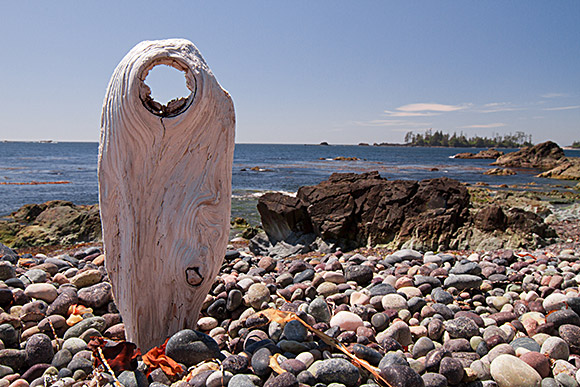
The view west to the Pacific Ocean from Catala Island, British Colombia, Canada.
During my 2013 kayak-camping expedition on the west coast of Vancouver Island, I spent a day by myself photographing and field recording Catala Island. You know you’re in a remote area when you refer to Vancouver Island as “the mainland.”
I found myself on a beach away from the direct Pacific swell, with a nice mix of pebbles and cobbles that made a wonderful rainstick-like tone when the gentle waves receded. (Of course, I’ve posted on recording waves before.)
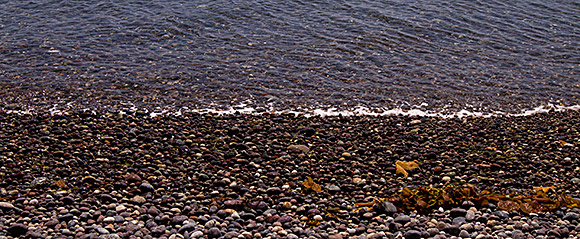
Cobble cobble cobble.
But as isolated as I was, man made sounds still managed to intrude. A lonely acoustic buoy in the distance bleated like a seasick cow on every incoming swell. You may be able to hear this in the background of this recording, faintly, although an aggressive 130Hz high pass filter helped remove the worst of it. Luckily this also removed the distant roar of the sea, actually helping to focus the sound on the small waves that really didn’t have much low-end to them at all.
Many dozens of miles from any road, on an island off another island off the main continent, the sounds of man still pervade. Or perhaps invade.
[soundcloud url=”https://api.soundcloud.com/tracks/140290561″ params=”color=ff5500&auto_play=false&hide_related=false&show_artwork=false” width=”100%” height=”166″ iframe=”true” /]
Tags: ambience, field recording, water | No Comments »
Posted: April 10th, 2014 | Author: Nathan | Filed under: field recording

The MV Uchuck III, passenger vessel and freigher on the west coast of Vancouver island. Kayak for scale.
One of the many reasons this site experienced an almost 1-year hiatus was a self-supported 2-week kayak expedition (check out the video of this amazing trip) on the northwest coast of Vancouver Island. The island is so riddled with deep networks of inlets that it’s actually quite hard to actually get to the exposed west coast. So, at the tiny logging town of Gold River, BC, we put our kayaks on the MV Uchuck III to get motored out to the coast.
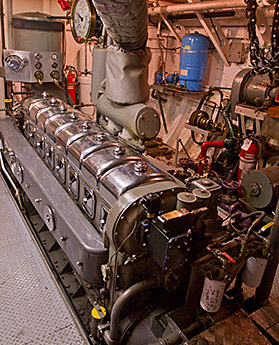
The MV Uchuck III engine room, starboard engine.
The Uchuck III is a lifeline for those that live on the edge of the world, where no roads exist and all travel must be by boat. The Uchuck III brings mail, deliveries, empty dumpsters, groceries, supplies, fish farm provisions, passengers and kayakers from Gold River out to Kyuquot, where we started our trip. It plays a vital role in this extremely remote region, and many generations of skippers and engineers have plied this route. The boat is so storied that there’s even a book about it and its predecessors.
The Uchuck III is a heavily modified World War II minesweeper. The inner double hull and stabilizers were removed to make room for a cargo hold, a crane was added, and the pilot house was moved astern. Its two propellers are powered by one straight-eight diesel engine apiece (a more cranky and surly version of the MV Tutoko, which I rode and recorded in the inlets of New Zealand’s Fiordland), and the skipper can’t control the engines from the pilot house: An actual telegraph is used to relay coded bell rings to the engineer below to take certain actions and “shift gears.” When this thing breaks down, parts need to be machined in Vancouver, from the original construction plans kept aboard.
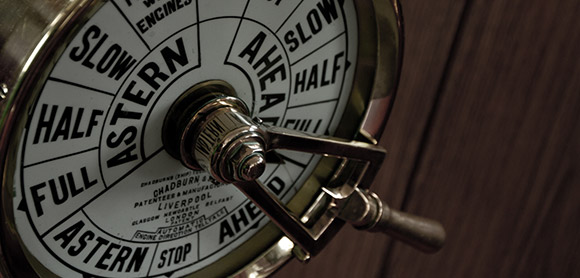
The engine telegraph unit.
Because we were just passing through, essentially, I didn’t get a chance to record too much material, but this post contains some of the perspectives I captured of the ship’s engines and cargo crane. Being a kayak expedition, I only had room for my Sony PCM-D50 recorder, which sucked for nature recording while kayaking…but it was more than sufficient for the loud pounding of the Uchuck III’s twin diesel engines.
[soundcloud url=”https://api.soundcloud.com/tracks/140290347″ params=”color=ff5500&auto_play=false&hide_related=false&show_artwork=false” width=”100%” height=”166″ iframe=”true” /]
Tags: engine, field recording, industrial, machine, mechanical, vehicle, water | 2 Comments »
Posted: April 2nd, 2014 | Author: Nathan | Filed under: field recording, gear, sound design
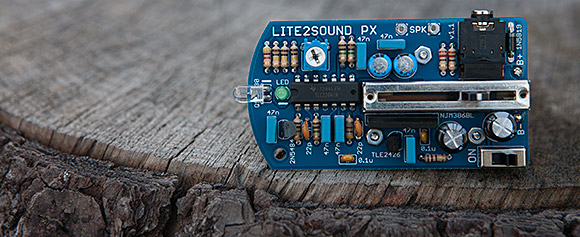
Rare Waves’ Lite2Sound PX, by Eric Archer: A photonic microphone!
I’ve previously written about the heavily-built, wickedly cool Grendel Drone Commander synth from Eric Archer. I check his site, Rare Waves, from time to time for new handmade electronic toys, and I was really intrigued by his newer Lite2Sound PX unit. This small device, in Eric’s words, “extracts audio from ambient light.” It’s a photodiode amplifier. Or a photosensitive microphone. Point it at light, it makes sound. It runs off a 9-volt battery, has a volume control, and a headphone jack. Simple, exciting, and a whole new world of sonic insanity. You can buy them as kits or, as I did, fully assembled.
Sounds pretty straightforward. If you just point it at bright, broad light sources, it’s kind of disappointing. It’s when you start listening to artificial lights in otherwise dim environments that some serious magic starts to happen. My experiments were conducted in and around high tech computer equipment, running an 1/8″ mini jack from the headphone output into my Sony PCM -D50 recorder.
Lights inside of PCs, modulated by fans…and further modulated by speaker grills as I passed the Lite2Sound from side to side. Ethernet network activity lights. Server disk access indicator lights. A close up of the power button of an XBox 360 while booting up. Pulsing lights of devices in standby mode. Halogen lamps behind spinning desk fans.
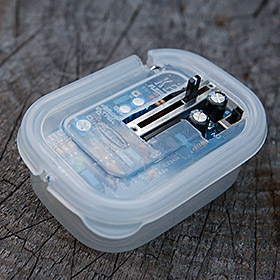
Lightly armored for future fieldwork!
The resulting sounds were astounding in their range: Static, glitches, distorted synth pads, pure sinewave tones, sawtooth-like tones, and much more. You can’t control it, really. It’s a tool of discovery, and its very nature encourages constant experimentation. It was so small and so perfectly complemented a handheld field recorder, I just wanted to take it everywhere and point it at everything! It imparted the same joy as when you start recording with contact microphones, or hydrophones: A new way to listen to the world around you. The more I used the Lite2Sound, I put it in a small plastic container (hacked with an XActo knife for access to controls and the headphone jack) in order to keep the components better protected.
Lite2Sound is a pretty narrowly-focused device and how useful it is to you depends on your taste for the unpredictable. Me, I adore this thing. Hell, I bought two (for future stereo photo-phonic insanity). It encourages constant experimentation, weighs nothing, and I can see using its output in both sound design and musical contexts. Eric Archer nails it again with an odd concept and a rock-solid, focused execution that results in a toy that just begs to be played with.
[soundcloud url=”https://api.soundcloud.com/tracks/139812053″ params=”color=ff5500&auto_play=false&hide_related=false&show_artwork=false” width=”100%” height=”166″ iframe=”true” /]
Tags: audio equipment, digital audio, field recording, sound design, sound effects | 3 Comments »






